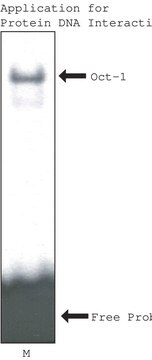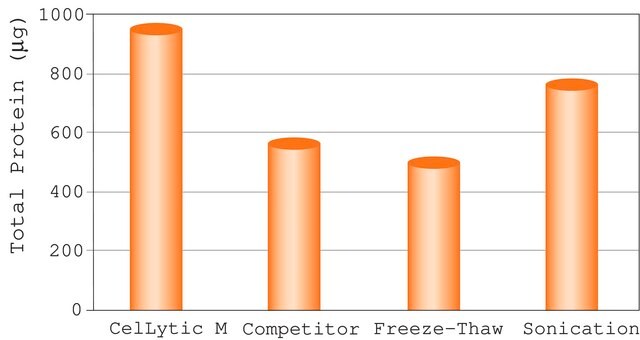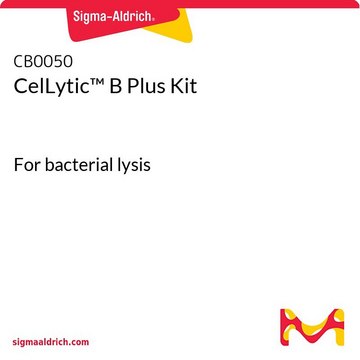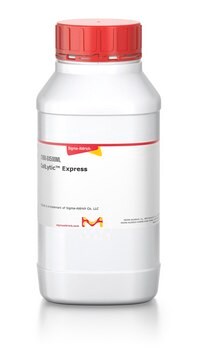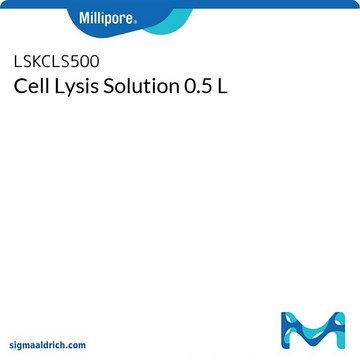B7435
CelLytic™ B Cell Lysis Reagent
For bacterial cell lysis, standard strength
Synonym(s):
Cell lysis reagent
Sign Into View Organizational & Contract Pricing
All Photos(1)
About This Item
Recommended Products
Quality Level
form
solution
Looking for similar products? Visit Product Comparison Guide
Application
CelLytic™ B Cell Lysis Reagent has been used for cell lysis for the extraction of coenzyme Q10, recombinant Src kinase associated phosphoprotein 1- glutathione S-transferases (GST) fusion protein and human α-synuclein.
A proprietary, non-denaturing formulation of zwitterionic detergents used for the lysis of bacterial cells and extraction of recombinant proteins.
Features and Benefits
- Higher protein extraction efficiency than traditional methods such as sonication and lysozyme
- Scalable for 1 to 25 grams of bacterial cell paste
- No interference with downstream applications such as affinity chromatography, IP, and Western blotting
- Compatible with protease inhibitors, inhibitor cocktails, chaotropes, salts, chelating agents and reducing agents
Other Notes
Detergent blend formulated in 40 mM Trizma® HCl (pH 8.0).
Legal Information
Covered by US Patent No 7,282,475 B2 and are sold for research use only. Commercial use requires addtional licenses.
CelLytic is a trademark of Sigma-Aldrich Co. LLC
Trizma is a registered trademark of Merck KGaA, Darmstadt, Germany
Related product
Product No.
Description
Pricing
signalword
Warning
hcodes
Hazard Classifications
Eye Irrit. 2 - Skin Irrit. 2
Storage Class
12 - Non Combustible Liquids
wgk_germany
WGK 3
flash_point_f
Not applicable
flash_point_c
Not applicable
ppe
Eyeshields, Gloves, type ABEK (EN14387) respirator filter
Certificates of Analysis (COA)
Search for Certificates of Analysis (COA) by entering the products Lot/Batch Number. Lot and Batch Numbers can be found on a product’s label following the words ‘Lot’ or ‘Batch’.
Already Own This Product?
Find documentation for the products that you have recently purchased in the Document Library.
Customers Also Viewed
Ken Motohashi
BMC biotechnology, 15, 47-47 (2015-06-04)
Seamless ligation cloning extract (SLiCE) is a simple and efficient method for DNA assembly that uses cell extracts from the Escherichia coli PPY strain, which expresses the components of the λ prophage Red/ET recombination system. This method facilitates restriction endonuclease
Monika Raab et al.
Scientific reports, 9(1), 10462-10462 (2019-07-20)
While the immune cell adaptor protein SKAP1 mediates LFA-1 activation induced by antigen-receptor (TCR/CD3) ligation on T-cells, it is unclear whether the adaptor interacts with other mediators of T-cell function. In this context, the serine/threonine kinase, polo-like kinase (PLK1) regulates
Prion-like seeding of misfolded alpha-synuclein in the brains of dementia with Lewy body patients in RT-QUIC
Sano K, et al.
Molecular Neurobiology, 55(5), 3916-3930 (2018)
Kazunori Sano et al.
Acta neuropathologica communications, 9(1), 182-182 (2021-11-14)
Serine 129 (S129) phosphorylation of α-synuclein (αSyn) is a central feature of Lewy body (LB) disease pathology. Although the neighboring tyrosine residues Y125, Y133, and Y136 are also phosphorylation sites, little is known regarding potential roles of phosphorylation cross-talk between
Ca2+ increases the specific coenzyme Q10 content in Agrobacterium tumefaciens
Ha SJ, et al.
Bioprocess and Biosystems Engineering, 32(5), 697-700 (2009)
Our team of scientists has experience in all areas of research including Life Science, Material Science, Chemical Synthesis, Chromatography, Analytical and many others.
Contact Technical Service


